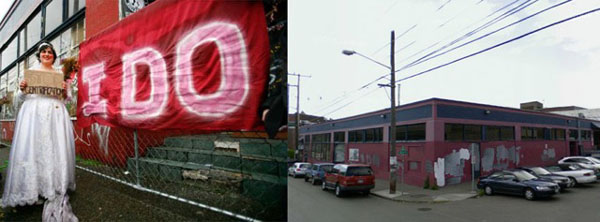The Answer To Gentrification: More Density?

In case you missed it, a Seattle woman married a building last month. The union was between Ms. Babylonia Aivaz and a 107-year-old warehouse on Capitol Hill at the corner of 10th and Union. Her desire to save the building (it has since been demolished) and stop gentrification prompted the event. I sympathize with the sentiment. Preservation is extremely important, not only for the character of the neighborhood but also for the people living in it. But is saving every building, especially the abandoned, the best way to fight gentrification?
In order to combat gentrification, it helps to try and understand the source. We all know what it is, but where does it come from? Who is to blame for this process that is taking place in many cities across the country? The answer is elusive. I’m not sure anyone has a definitive remedy. There are many factors that come into play. Things like neighborhood location, amenities and character are all a part of the equation, but there is something more to it. There’s a coolness factor that takes hold. You know, first the artists move in and then… So if we can’t pinpoint the cause how can it be fought?
Cities and people have tried several ways to combat this force with varying degrees of success. Rent control has been used in many places, but the unintended consequences can have long-term dire effects. Building affordable housing is another approach, but does it make sense to use expensive new construction for this use? It’s unsupported without subsidies. The seminal urban planning author Jane Jacobs advocated for the preservation of old buildings because they are cheaper and can be supported with lower rents. Although, the old buildings were new buildings at one time, so how do you increase the supply of old buildings without building new ones?
If implemented correctly, maybe there is a market solution. Preservation is key. There is a neighborhood aesthetic and certain buildings that should never go away. But, when a neighborhood becomes desirable, without a rise in the number of units rents will escalate. It’s simple economics: supply and demand. To drive down the ascending cost of rent, density must be increased. Whether through new construction, renovation or adaptive reuse, more units must be built. After all, living in dense, compact communities is one of the best things we can do for our planet. They lower dependence on driving, increase access to public transportation and have more efficient buildings and use of infrastructure. This is what makes New York the nation’s low-carbon leader. So maybe, Ms. Aivaz should be advocating that new buildings have more density to reduce development pressure on the functioning, existing old buildings.
>>>
Ian Fishburn, LEED AP, is currently working on a master’s degree at UW´s College of the Built Environment. He is passionate about real estate with a focus on creative, sustainable urban development, and has worked for the past decade in development, construction and design.Â

